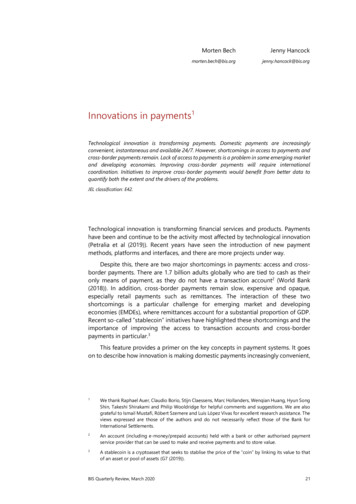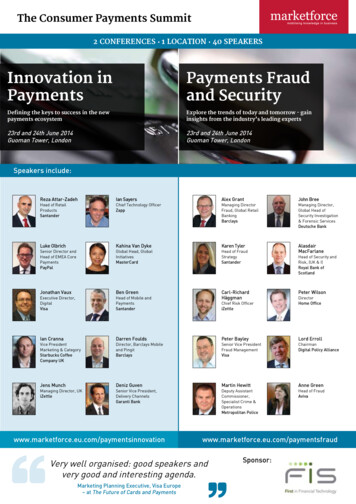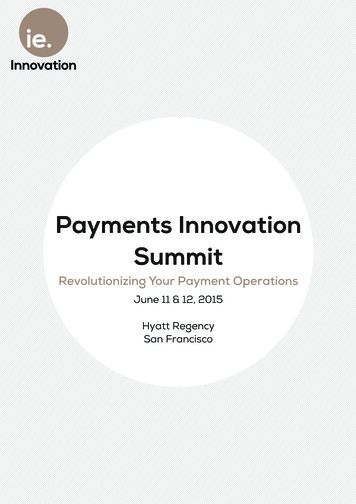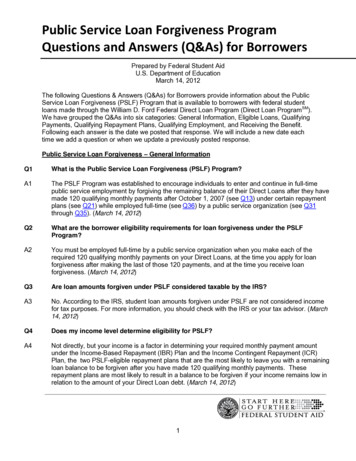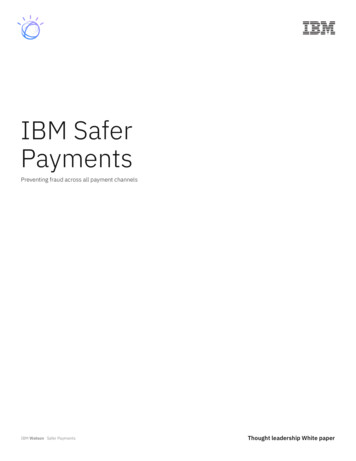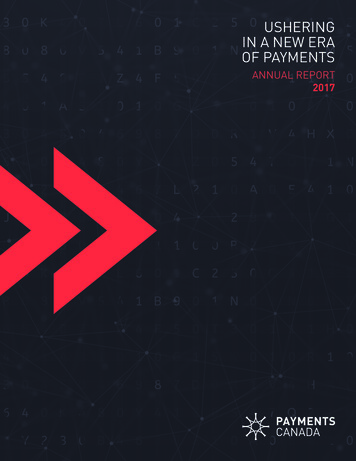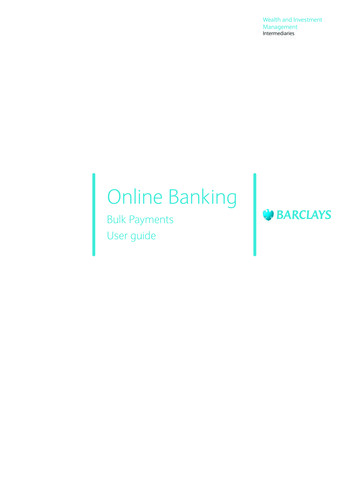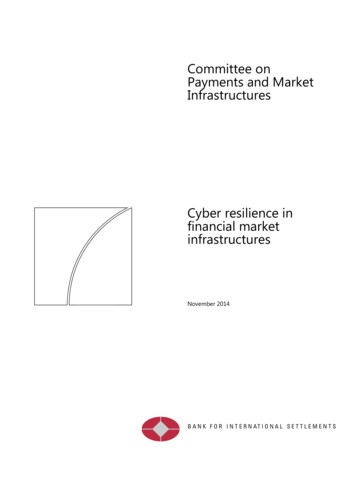
Transcription
Committee onPayments and MarketInfrastructuresCyber resilience infinancial marketinfrastructuresNovember 2014
This publication is available on the BIS website (www.bis.org). Bank for International Settlements 2014. All rights reserved. Brief excerpts may be reproduced ortranslated provided the source is stated.ISBN 92-9131-988-6 (print)ISBN 92-9131-989-3 (online)
Contents1.Introduction . 12.Basic assumptions. 23.Why are cyber risks special? . 44.Integrated approach to cyber resilience . 45.Sector-wide considerations . 12Annex 1: Glossary . 14Annex 2: Members of the working group . 16CPMI – Cyber resilience in financial market infrastructures – November 2014iii
1.IntroductionCyber attacks*1 against the financial system are becoming more frequent, more sophisticated and morewidespread. Given the critical role that financial market infrastructures (FMIs) play in promoting thestability of the financial system, the Committee on Payments and Market Infrastructures (CPMI)2 hassought to understand the current cyber risks faced by FMIs and their level of readiness to effectively dealwith worst case scenarios.The Committee established a working group (WG; see Annex 2) to analyse the relevance ofcyber security* issues for FMIs and their overseers within the context of the Principles for FinancialMarket Infrastructures (PFMIs).*WG members carried out a stocktaking exercise in the form of interviews with FMIs, theirparticipants, providers and other relevant stakeholders in their respective jurisdictions. The primaryobjective of these interviews was to better understand FMIs’ abilities and perspectives in the field ofcyber resilience.* From the interviews, the group learned that: (a) cyber resilience is steadily becoming atop priority for FMIs; (b) FMIs are addressing the risks to broader financial stability posed by cyberthreats* to their own systems, notwithstanding the challenges of doing so; (c) FMIs consider a two-hourrecovery time objective (2h-RTO*) in the context of an extreme cyber event to be challenging (and maytake several years to achieve), but some believe there are a number of feasible solutions that can beexplored or may already be in place to minimise recovery times; and (d) FMIs support the regulatorycommunity in providing the impetus for communication and coordinated action in the pursuit ofeffective solutions.In addition, although senior management at FMIs increasingly considers cyber resilience a toppriority, industry leaders also generally believe that current efforts to move the industry towards theachievement of faster target recovery objectives need to be stepped up given the growing threat to thefinancial sector. The aim of this document is to describe some of the evolving practices and conceptsthat FMIs are applying and discussing in their approach to cyber resilience, and also to lay thefoundation for the work necessary to strengthen financial stability by enhancing cyber resilience in theFMI industry as a whole.The report is guided by the assumption that FMIs must be able to recover operations quicklyand settle activities by end-of-day even in extreme scenarios. Given the state of FMI cyber resilience andthe industry perspectives shared by the FMIs interviewed, authorities concluded that coordinated actionand possibly guidance in addition to PFMI Principle 17 may be justified.1Terms marked with an asterisk are defined in the glossary (Annex 1).2Prior to 1 September 2014, known as the Committee on Payment and Settlement Systems (CPSS). Please note that referencesto reports published before that date cite the Committee’s old name.CPMI – Cyber resilience in financial market infrastructures – November 20141
2.Basic assumptionsThe following three assumptions form the basis of this report: (i) the PFMIs constitute the starting pointof the analysis; (ii) settlement finality is not affected; and (iii) the 2h-RTO and end-of-day settlementrequirements embedded in Principle 17 of the PFMIs are expected to be met.PFMI basisSettlementfinality2h-RTO end-of-daysettlement2.1The PFMIs as the starting pointThe PFMIs are international standards for FMIs, developed by the CPMI and the Technical Committee ofthe International Organization of Securities Commissions (IOSCO), applicable to SIPSs,* SSSs,* CSDs,*CCPs* and TRs.* The overall objective of the PFMIs is to ensure that FMIs promote stability and efficiencyin the financial system. The PFMIs are in the process of being implemented in many jurisdictions.Principle 3 requires a sound risk management framework for comprehensively managing legal, credit,liquidity, operational and other risks. Operational risk and governance are specifically addressed inPrinciples 17 and 2,* respectively. Cyber risk falls within this domain. Any issues or recommendationsconnected to cyber resilience in FMIs are expected to be handled within the context of the PFMIs.In line with the PFMIs, the minimum standards for cyber risk management are not expected tovary by type of FMI. However, the specific type of FMI and/or the corresponding impact of a cyber attackon the financial system may influence the specific approach or tools needed to meet those minimumstandards, in terms of:1.whether the FMI contains information that is not available anywhere else and/or whether itregisters basic ownership rights (eg in the case of CSDs and certain TRs) that – in the event ofloss – would create major ownership issues;2.the magnitude of the disruption to the financial system that an FMI could generate, asdetermined by its position in the transaction chain* and/or the size and number of participantsit serves; and/or3.whether an FMI enjoys a (near) monopoly and therefore positions itself as the only option forthe fulfilment of its services.2CPMI – Cyber resilience in financial market infrastructures – November 2014
2.2Settlement finalityThe finality of settlement is a legally defined moment, ie the irrevocable and unconditional transfer of anasset or financial instrument, or the discharge of an obligation by the FMI or its participants, inaccordance with the terms of the underlying contract.The finality of settlement is important for the stability of the financial system. Credit, liquidityand legal risks are allocated among the parties to payment and securities transactions based on theprinciple of finality. The liquidity condition of financial institutions and their customers depends on thecertainty of the assumption that transactions that are considered final will remain final. While erroneousdata could result from an extreme cyber event, assurance of the finality of those transactions is necessaryto maintain financial stability.The WG concluded that if there were a case where a recipient had no legal right of acquisitionbased on an underlying claim and it was decided that the transfer order might have to be reversed by anentry of opposite magnitude and effect to offset such invalid or unauthorised transaction, the originalsettlement by the system would remain protected.2.3The 2h-RTO objective is relevant for cyber resilienceAs FMIs play a critical role in domestic and international financial stability, the PFMIs explicitly requirethat an FMI have a business continuity plan that addresses events which threaten to significantly disruptoperations, including events that could cause a wide-scale or major disruption. Although some parts ofthe PFMI text are written in terms of recovery from physical threats, the need for rapid resumption of keyservices in response to cyber attacks is equally important. Therefore, Principle 17 on operational risk isalso intended to encompass cyber security (see excerpts below).PFMI Principle 17:“An FMI should identify the plausible sources of operational risk, both internal and external, and mitigate theirimpact through the use of appropriate systems, policies, procedures, and controls. Systems should be designed toensure a high degree of security and operational reliability and should have adequate, scalable capacity. Businesscontinuity management should aim for timely recovery of operations and fulfilment of the FMI’s obligations,including in the event of a wide-scale or major disruption.”PFMI Principle 17, Key Consideration 6:The business continuity plan “should be designed to ensure that critical information technology (IT) systems canresume operations within two hours following disruptive events”. Moreover, the plan “should be designed toenable the FMI to complete settlement by the end of the day of the disruption, even in the case of extremecircumstances”.PFMI Principle 17, Explanatory Note 3.17.13:“A business continuity plan should have clearly stated objectives and should include policies and procedures thatallow for the rapid recovery and timely resumption of critical operations following a disruption to a service,including in the event of a wide-scale or major disruption.”Although FMIs have identified challenges to achieving a 2h-RTO in an extreme cyber scenario,senior managers understand and support this objective. Section 4 of this report discusses in more detailthe concepts and practices that some FMIs believe may assist in shortening recovery times.CPMI – Cyber resilience in financial market infrastructures – November 20143
It is worth noting that a 2h-RTO could involve trade-offs with other aspects of cyber securityand resumption. For example, in some cases, ensuring a 2h-RTO may mean that forensic analysis of theattack, needed to preserve the integrity of the evidence collected and to ensure that it can be usedeffectively in a legal case, cannot be completed as easily or comprehensively as in the case of a longclosure of systems. While forensic analysis may be postponed, creating the conditions to perform itpost-event is a responsibility that cannot be dismissed.3.Why are cyber risks special?The PFMIs identify operational risk (and the cyber risk belonging to it) as one of the core risks confrontingFMIs. Because cyber risk is a relatively new, highly complex and rapidly evolving phenomenon, it can bevery difficult to manage. Cyber attacks may take the form of persistent malicious action by third partiesintent on creating systemic harm or disruption, with concomitant financial losses. It may be extremelyhard to determine the extent of an event, how to remedy it and how to recover. The very unpredictabilityof cyber risk dictates the urgency of having a proper approach in place to manage it.Over the past several years, cyber threats have emerged as a growing systemic risk to FMIs.There are a number of reasons for this: (i) the role of technology in the provision of financial services hasdeepened; (ii) the degree of interdependency and interconnectedness between operators in financialmarkets is very high and growing; and (iii) both attackers and their motivations have become morediverse, bringing fresh threats from unexpected sources. Attackers now include “hacktivists”, who seekmerely to disrupt activity; cyber criminals motivated by financial gain; terrorists aiming to cause politicaland financial instability; and nation state-related actors attempting to interfere with or gain access tosensitive information, or to cause systemic instability. The biggest challenge in making FMIs cyberresilient is managing their complexities and interdependencies by proactively addressing failures,adopting effective resilience techniques, and resolving problems through cooperation.Attackers are also using increasingly sophisticated methods. For instance, in recent years a newclass of intrusion, known as an advanced persistent threat (APT),* has emerged and continues to evolve.At the same time, entry points through which an FMI could be attacked are multiplying and includecounterparties, vendor products, employee workstations and rogue employees. Social engineering*often serves as a means to deliver malware* into IT systems (eg spear-phishing*).Given their sophistication, range of motivations and pervasive scope, cyber attacks can presentunique challenges to FMIs’ operational risk management frameworks. In some cases, the riskmanagement and business continuity protocols used in the event of physical attacks are ineffective orcould actually exacerbate a cyber attack. For example, automated backup systems that may helppreserve sensitive data in the event of a physical attack on a head office could be as vulnerable to acyber attack as the primary system(s), and might in some instances help the malware propagate faster.4.Integrated approach to cyber resilienceAn integrated approach to cyber resilience is a means to ensure the survivability of FMI operations, evenif services have to be conducted in a degraded state. Survivable operations are designed to absorb theshock of an attack without systems breaking down totally. In order to cope with the idiosyncrasies ofcyber attacks and enable services to resume, FMIs typically follow an integrated approach based on theadoption of a cyber resilience framework developed internally or adapted from a more genericframework – examples being: the NIST framework,* published in February 2014; the World EconomicForum’s cyber resilience approach,* published in January 2014; and the 2013 MITRE framework.* External4CPMI – Cyber resilience in financial market infrastructures – November 2014
consultants or auditors are sometimes hired to advise on the implementation of a cyber resilienceframework.Although the frameworks differ in terms of their exact setup and categorisation, an integratedapproach to cyber resilience typically covers three broad dimensions:1.Scope: Generally, FMIs’ cyber resilience frameworks address a number of scenarios that mayresult from a cyber attack, including a confidentiality breach, an availability breach and anintegrity breach.2.Cyber governance:* The framework covers not just an FMI’s IT infrastructure, but also people,processes and communication.3.Range of measures: It is essential for an FMI to apply a wide variety of controls to effectively(i) prevent a cyber attack from occurring, (ii) detect an attempted or successful attack, and(iii) resume services at pre-agreed levels after an attack.4.1ScopeGenerally, FMIs’ cyber resilience frameworks aim to address three broad scenarios:1.A confidentiality breach, which involves confidential information being stolen.2.An availability breach, where the services provided by an FMI are inaccessible or unusable upondemand by authorised entities (eg because the channels of communication between an FMIand its participants and other organisations are unavailable) but where the systems per se arestill intact.3.An integrity breach, which is the corruption of an FMI’s data or systems affecting the accuracyor completeness of the information and processing methods (and which could also impact theavailability of services).The focus of the majority of cyber attacks continues to be on compromising confidentiality(eg stealing sensitive data) and degrading system availability (eg DDoS* attacks). However, morerecently, the risk of attacks impacting the integrity of either the software or the data (or both) of an FMICPMI – Cyber resilience in financial market infrastructures – November 20145
has been receiving increasing attention. Three generic risk scenarios are briefly illustrated below inincreasing order of severity of impact on an FMI’s operations and on the financial system.The main purpose of this illustration is to highlight the diversity of challenges to the resilienceof FMIs in different scenarios. Measures intended to protect against a physical incident (such as localsystem duplication and remote data centres) may not be equally effective against cyber attacks (see alsonon-similar facility in Section 4.3.3). This could especially be the case with regard to integrity.SCENARIO 1SCENARIO 2SCENARIO 3ConfidentialitybreachAvailability breachIntegrity breach Confidential datastolen throughcyber attack. Unavailability of servicesthrough eg denial-of-serviceattack. Ability to provideservices notnecessarilyimpaired. Impact on egcommunication between FMIand participants, support toparticipants, FMI’s updateson availability of services,communication withsuppliers (market feeds) andinformation exchange withcounterparties. Attack may serveas the initialphase of a moresophisticatedscenario.Can be difficult torecognise andmitigate in atimely manner. Effect of disruption onparticipants and financialmarket worsens the longerthe downtime.Damage to FMI’sreputation.4.2 FMI’s core data or systems are corrupted in a cyberattack. Integrity of FMI’s information or systems no longertrusted. Backup systems possibly corrupted as well. Initially, systems may seem to process normally. Decision should be taken whether to stop service inorder to restore systems to a trusted state. Time to detect and analyse problem could beconsiderable. Time needed to restart service delivery on the basis of aclean situation could be substantial. Impact may be systemic since participants’ positionswithin FMI could be blocked and no longer trusted. Could trigger a loss of confidence in the financialmarkets, eg due to disputes or confusion aboutownership rights and financial positions. Possible knock-on effects on other FMIs, participantsand their customers and markets, including liquidityand credit effects.Cyber governanceFMIs that effectively manage cyber resilience do so in part because they have implemented acomprehensive governance framework. They acknowledge that cyber resilience is not just aboutinformation and communication technologies. Rather, it has a broader impact and relevance for theseorganisations. Four general areas are covered in a governance framework: people, technology, processesand communication.4.2.1PeopleAn integrated approach means that an FMI’s entire staff – from operational to senior management aswell as board level – are involved in the two key components of cyber resilience: security and businessresumption. Effective cyber resilience requires that cyber risks be comprehensively addressed within theFMI’s risk management framework.The lead taken by an FMI’s senior management is an important factor in cultivating a stronglevel of awareness of and commitment to cyber resilience throughout the organisation. Generally, FMIsare aware that cyber risk is not only an operational issue but rather an enterprise-wide risk that threatenstheir viability as going concerns. Cyber resilience is accordingly an enterprise-wide issue, and internalauditors may play a significant role in confirming the efficacy of cyber risk initiatives and policies, and inensuring that an FMI attaches appropriate importance to cyber resilience.6CPMI – Cyber resilience in financial market infrastructures – November 2014
A consistent feature of FMIs with a sound information security policy in place is a governancestructure which ensures that information security is considered in all aspects of the business and aculture that recognises its importance. An integrated approach means that cyber resilience is treated aspart of the core business, and is not something tacked onto existing tasks. In such organisations, staff atall levels, including top management, undergo targeted training on a regular basis to increase overallawareness and enhance preparedness to deal with a range of cyber threat scenarios. Organisation-wideawareness is crucial. With a high level of awareness across all employees, it is more likely that a potentialvictim will report a suspected instance of cyber infiltration and that the appropriate incidentmanagement process will be triggered in time to mitigate damage.4.2.2TechnologyAttackers generally identify vulnerabilities to bypass intrusion detection tools. They exploit the gaps orseams that exist between subsystems and business processes in complex environments. They alsobenefit from situations where legacy software lacks sufficient security support. Currently, cyber attackersexploit vulnerabilities in an individual institution’s IT infrastructure to unleash damage across thefinancial industry, as extensively reported in the press. As a precaution, most FMIs give prominence to ITin their cyber governance and endeavour to make their systems more resilient, implementing layeredcyber resilience measures to counter threats. Examples of IT governance measures, such as accesscontrols, are given in Section 4.3.4.2.3ProcessesIn an integrated approach, the implications of cyber resilience from an operational risk perspectiveshould be properly assessed as part of the decision-making process at board level (covering eg newservices, products, IT investments and an FMI’s organisational structure). Some FMIs have introducedclear cyber resilience-related processes, including identification of responsibilities and accountabilities.One such process is risk acceptance. As part of operational risk management, it includes input andanalysis on cyber resilience and business continuity from relevant staff at all levels, including businessunits, internal audit, the chief information security officer and the board.4.2.4CommunicationGiven how interconnected FMIs are with their participants, other FMIs, service providers and third-partyvendors, effective channels of communication between them are essential. However, information-sharingcan be hampered by the difficulty of maintaining trusted relationships with a broad range of securityteams, which are often based overseas. Sufficient trust between an FMI’s security teams and itscounterparties is crucial for them to be comfortable with sharing sensitive information.Most FMIs appear to be striving to ensure the continuity of their information andcommunication channels both in normal and stressed circumstances. In the event of a cyber attack,timely communication with stakeholders, including relevant authorities, is critical to resuming operationsand preventing the attack from spreading.4.3Range of measuresThe third dimension of an integrated cyber resilience approach is the range of security measures to betaken, mainly in the area of IT. There is no silver bullet that effectively protects against all cyber attacks.Rather, FMIs are diversifying their investments across different categories (prevention, detection andrecovery) of cyber security measures and tools. The breakdown of security measures into prevention,detection and recovery components is not strict, since measures are mutually reinforcing and serveseveral purposes at once.CPMI – Cyber resilience in financial market infrastructures – November 20147
For instance, it is common for solutions to combine prevention and detection functions(eg anti-virus software both detects and isolates malicious code). Likewise, steps to enhance recoverycan include process segmentation (which can strengthen prevention) combined with frequentcheckpoints, validation and reconciliation (which can strengthen detection).In the past, cyber resilience was focused on prevention, and measures often involved retrofitting IT security solutions to existing systems. An increasing amount of attention and indeed investmentare now being devoted to improving monitoring, detection and recovery capabilities.These investment decisions are multifaceted. The cyber threat landscape is constantly evolving,and the industry must contend with the complexity and high costs of eventual solutions as well as theincreasing likelihood and severity of extreme cyber events. Although committed and aware of theimportance of information security, FMI management may, in some cases, face challenges in making theinvestments that may be necessary.Some FMIs have hinted, however, that near-term steps can be taken to progress towardsmaking 2h-RTO and end-of-day settlement a reality during an extreme cyber event. The measuresnecessary are likely to require investments in a combination of prevention, detection and recoverytechniques. These three elements, in the context of 2h-RTO, are mutually reinforcing and must beconsidered jointly. The following sections detail examples of the key practices, concepts and strategiesthat many FMIs are adopting to build up cyber resilience, reduce service downtime and ensure end-ofday settlement.4.3.1PreventionFMIs recognise that many of the following prevention measures are basic elements of a stronginformation security programme. They also view these elements as key steps towards a quick resumptionof operations. Nevertheless, no FMI today can confidently assume that cyber attacks can be prevented.The security hypothesis is that FMI systems are compromised and that FMIs need to develop intruderdetection capabilities (see Section 4.3.2).IdentificationFMIs are improving their understanding of the business context, of the resources that support criticalfunctions and of the related cyber risks, thereby focusing and prioritising their efforts, consistent withtheir risk management strategy and business needs.AwarenessApproaches to raising cyber awareness on all levels within an organisation (see Section 4.2.1) includestaff training and threat analysis – for example, in the context of combating social engineering – andprovide a basis for building and developing an effective security framework.Defence in depthPractices commonly referred to as “defence in depth” encompass network security management. This isthe process of layering systems and system components and building firewalls, so that if one componentis compromised, it does not give the attacker access to another. Internet-facing applications, such asdesktop e-mail, are considered to be at greatest risk and are therefore segregated from core systemcomponents.Prevention of malicious activityMalicious activity may be prevented through the use of anti-virus solutions as well as analysis of webservices and infrastructure to identify vulnerabilities that attackers may exploit to inject malicious code.Such analysis includes monitoring and inspection of suspicious web-based e-mail and traffic for8CPMI – Cyber resilience in financial market infrastructures – November 2014
malicious code, DDoS attacks and any attempts by hackers to capture user details. Once suspicioustraffic is identified, it can be blocked and action undertaken to nullify the source of the threat.Reducing attack surfaces*An important part of prevention is curtailing the points through which an attacker can gain access to anFMI’s network. Practices include limiting the number of internet gateways, whitelisting software andisolating critical parts of the network.Application developmentPrevention can also be instilled during the software development life cycle for applications developed inhouse. The development process should include enforcement and testing of secure software codingstandards to limit the number of vulnerabilities introduced into production systems.Testing and application managementSecurity audit and penetration testing involve the use of advanced analysis and simulated attacks toensure compliance with security standards and to identify vulnerabilities in existing securityarrangements. Penetration testing is regularly carried out by FMIs, both internally and in collaborationwith external consultants.Application management includes application whitelisting and security-related patching.Application whitelisting ensures that only approved applications are installed on servers andworkstations, thereby minimising the risk of an attacker installing malicious applications within theoperating environment. Patching addresses vulnerabilities in a system by applying updates toapplications and operating systems in a timely manner as they become available. The discontinuation ofsupport for a particular application leaves it more vulnerable to attack.Access controlAccess control measures are essential to prevent unauthorised access to data and/or systems.Administrative privileges are limited to those staff members who really need to have them; senior staffare alerted whenever a user seeks privileged access. By minimising the number of users withadministrative privileges and following the principle of “least privilege”,* this approach aims to limit boththe risk of an attack from within an organisation and the number of entry points for an external attacker.As a detection measure, access logs and alerts are used to monitor privileged access and identifyunusual activity.Infrastructure control and developmentThe design of the IT infrastructure can have significant implications for security management. As controlson the infrastructure are tightened up, preventive and proactive measures are taken. Virtual machines(VMs)* or virtual desktop image (VDI)* are technical measures that enable staff to access the desktopwhich is hosted in a centralised server. As desktop security and data protection are centralised, securitypatches are easily deployed and granting or denying access to a specific user is more straightforwardlyresolved.VMs can be used to create non-persiste
CPMI - Cyber resilience in financial market infrastructures - November 2014 1 1. Introduction Cyber attacks*1 against the financial system are becoming more frequent, more sophisticated and more widespread. Given the critical role that financial market infrastructures (FMIs) play in promoting the
